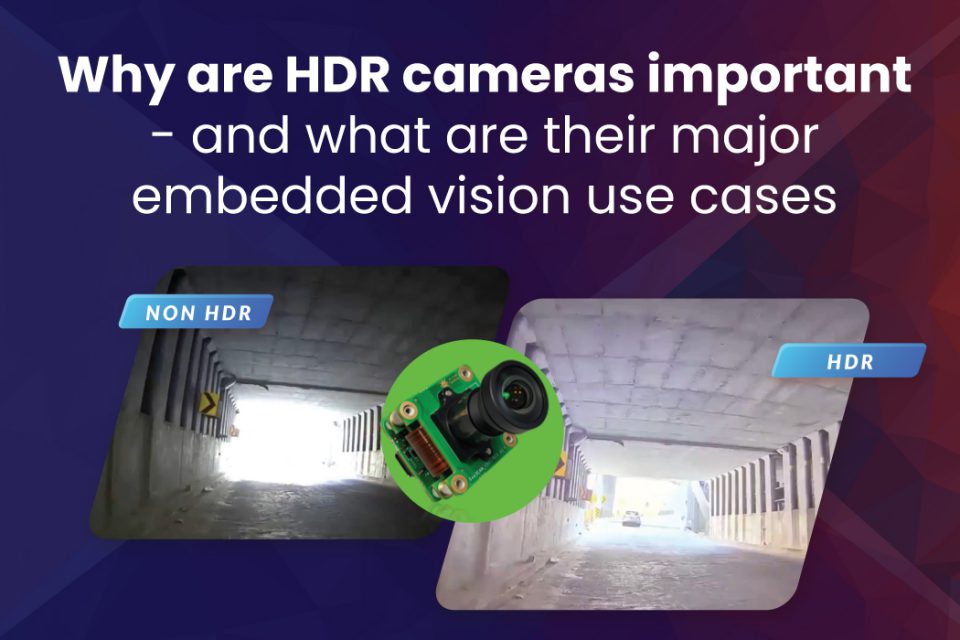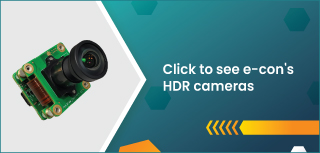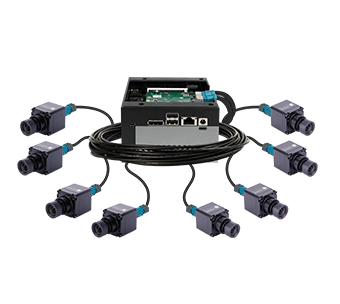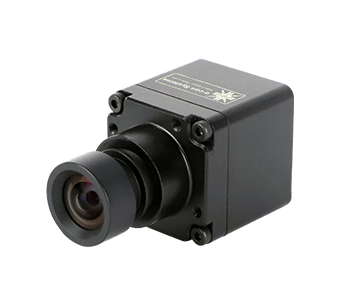In its early days, embedded vision had its limitations owing to the lack of high quality cameras and high-performance embedded processors. Of the many challenges facing embedded cameras, the inability to capture a scene with bright as well as dark areas was a great bottleneck in many camera-enabled embedded devices. It limited the scope of their usage since most outdoor applications like smart traffic systems or autonomous vehicles would be exposed to such conditions regularly.
Today, however, the embedded vision industry is going through a transformation with the advent of high-end cameras and processing platforms with performance as high as 275 TOPS. This has also led to the rise of the HDR (High Dynamic Range) technology that proved to be the catalyst these embedded devices required. HDR cameras enable these embedded vision systems to sustain high performance, irrespective of the lighting condition. In this blog, let’s look at how an HDR camera works and some of its key embedded vision use cases that will continue to be popular in 2022 and beyond.
What is High Dynamic Range (HDR)?
Dynamic range can be defined as the total amount of light from a particular scene. So, optimized exposure time is a huge necessity since this ensures that the brightness level in bright areas and dimness level in dark areas don’t affect the quality of imaging. If a captured image contains many bright areas and many dark areas covered in shadows, the scene could be described as having a high dynamic range.
How do HDR cameras work?
An HDR camera remains agnostic to lighting conditions. An HDR image is extracted by capturing, let’s say, three images of the exact scene; that too, at varying shutter speeds (or exposure times). The result outputs would be based on how much light was allowed to pass through the lens – creating bright, medium, and dark images. With the help of an advanced image signal processor, all the three versions of the images are stitched together to form a complete scene.
To learn more about what an HDR camera is and how it works, please have a look at What is High Dynamic Range (HDR)? How do HDR cameras work?
Key Embedded Vision Applications of HDR Cameras
Numerous embedded vision applications require an HDR camera. And new use cases are emerging every day. Below are some of the most popular use cases of embedded vision where HDR is recommended.
- Smart trolley & smart checkout systems
- Outdoor AMRs (Autonomous Mobile Robots) & autonomous vehicles
- Automated sports broadcasting
- Smart traffic monitoring
- Surround-view systems
Smart trolley & smart checkout systems
Smart trolleys and smart checkout systems enhance customer experiences in retail stores by automating the checkout process using vision-enabled systems. This helps customers avoid waiting in a long queue during checkouts. In these devices, a multi-camera system is mounted on a shopping trolley or checkout counter to automatically capture images of objects in a shopping cart.
To learn more about how embedded vision transforms smart trolley and checkout systems, read How embedded vision accelerates smart trolley and smart checkout journeys.
If you are interested in knowing how embedded vision helps in the smart retail revolution, you could also look at How embedded vision is contributing to the smart retail revolution.
As for why HDR is required in smart trolleys and smart checkout cameras, it’s because of the lighting in retail stores (both natural and artificial). Many of these stores have lightings that brighten up only a section of the scene to be captured. This may result in the inability to capture the complete object for accurate identification. HDR prevents this by adjusting the exposure time to capture sections of a scene with varying light intensities.
Outdoor AMRs (Autonomous Mobile Robots) and autonomous vehicles
Some AMRs and autonomous vehicles in outdoor environments are agricultural robots, autonomous tractors, patrol robots, and delivery robots. Most of these autonomous systems operate at different times of the day. For instance, agricultural robots are deployed in farms and fields to capture details of crops, bugs, weeds, etc.
Depending on which time of the day they are operating, the amount of light that passes through their camera lenses will differ. It is where a camera with a high dynamic range can help. It can adapt to changing lighting patterns and capture images accurately in bright and dim lighting conditions. In turn, this high-quality imaging data goes a long way to improve the performance of autonomous robots/machines.
Automated sports broadcasting
Even though HDR is not a must-have feature for AI-driven automated sports broadcasting, it is recommended in cases where cameras have to directly face the sun. Also, if the matches to be captured occur mostly under bright sunlight, the importance of having HDR increases. So, the cameras should come with high sensitivity to capture images in challenging lighting conditions.
To understand more about choosing a camera for automated sports broadcasting and the role of HDR in it, read Choosing the right camera for automated sports broadcasting – everything you need to know.
Learn how e-con Systems helped a leading Autonomous Mobile Robot manufacturer enhance warehouse automation by integrating cameras to enable accurate object detection and error-free barcode reading.
Smart traffic monitoring
Varying lighting conditions are inherent to traffic management. And often, the camera has to face sunlight, making it extremely difficult to produce a visible image directly. HDR comes to the rescue here as well. HDR cameras make it possible for smart traffic systems to accurately read the number plates of vehicles, recognize people’s faces, measure the speed of moving vehicles etc.
To know more about choosing the right camera for smart traffic monitoring, please visit Choosing the right camera solution for smart traffic management.
Surround-view systems
Large vehicles have started to rely heavily on surround-view capabilities inherent to Advanced Driver Assistance Systems. They use a multi-camera system to create a 360-degree view of the scene – offering high-speed imaging data. Of course, HDR is critical, considering multiple cameras must provide clear images despite varying on-road lighting conditions. Furthermore, the image sensor used in HDR cameras typically should have very high quantum efficiency – making it extremely sensitive to light.
Other use cases of HDR camera systems include security/smart surveillance, remote patient monitoring, parking lot management, ATMs, retail kiosks, etc.
HDR cameras from e-con Systems
e-con Systems has been designing, developing and manufacturing custom and off-the-shelf camera solutions since 2003. We have an impressive portfolio of HDR cameras, including STURDeCAM31, which is one of our recent products rapidly gaining popularity.
STURDeCAM31 is a 3MP GMSL2 HDR IP69K camera with a 15-meter coaxial cable and an automotive-grade 3MP CMOS sensor. Its HDR capability (up to 120dB + LED Flicker Mitigation) ensures reliable images in challenging outdoor light conditions. STURDeCAM31 also comes equipped with a well-tuned Image Signal Processor (ISP) that produces exceptional image quality.
Other highlights:
- Based on the 1/2.42″ ISX031 CMOS image sensor from Sony®
- IP69K M12 lens – focused and glued in our factory
- Gigabit Multimedia Serial Link 2 (GMSL2) interface with FAKRA connector
- External Trigger support for synchronized multi-camera streaming
Some of the other HDR cameras we offer include:
HDR USB Cameras
- See3CAM_CU31 – ISX031 3MP 120dB HDR USB Camera
- See3CAM_CU81 – AR0821 4K HDR USB Camera with 1/2″ sensor
- e-CAM83_USB – 4K High-resolution HDR USB camera based on Sony IMX317
- See3CAM_CU20 – Full HD HDR USB3.1 Gen1 Camera
- See3CAM_CU22 – Full HD HDR USB Camera with LFM
- Hyperyon® – 2MP SONY STARVIS IMX290 Ultra Low-light USB camera
HDR Camera Modules
- e-CAM82_CUMI0821_MOD – 8MP (4K) HDR MIPI Camera Module
- e-CAM27_CUMI290_MOD – 2MP IMX290 Camera Module
- e-CAM20_CU0230_MOD – 2MP Industrial grade HDR Camera Module
NVIDIA HDR Cameras
- STURDeCAM34_CUOAGX – 3MP 140dB HDR GMSL2 Camera for NVIDIA® Jetson AGX Orin™
- STURDeCAM31_CUOAGX – 3MP 120dB HDR NVIDIA® Jetson Orin™ Camera
- e-CAM81_CUNX – 8MP HDR camera for NVIDIA Jetson Xavier NX/TX2 NX/Nano
- NileCAM21_CUXVR – HDR GMSL2 multi-camera solution for NVIDIA Jetson AGX Xavier
- e-CAM20_CUXVR – Sony STARVIS IMX290 synchronized HDR multi-camera system
- SmarteCAM – IP66 rated AI HDR smart camera
GMSL2 HDR Cameras
- STURDeCAM34 – 3MP AR0341AT 140dB HDR Camera(IP69K)
- STURDeCAM31 – IP69K Automotive Grade GMSL2 HDR camera with LFM
- STURDeCAM20 – IP67 rated Full HD GMSL2 HDR camera module
- NileCAM21 – Full HDR GMSL2 HDR camera module with LFM
Smart HDR Cameras
Please visit our HDR cameras hub page to have a look at all our HDR cameras. You can also check out the Camera Selector page to view our entire camera portfolio. If you need help integrating HDR cameras into your products, please write to camerasolutions@e-consystems.com.

Suresh Madhu is the product marketing manager with 16+ years of experience in embedded product design, technical architecture, SOM product design, camera solutions, and product development. He has played an integral part in helping many customers build their products by integrating the right vision technology into them.







